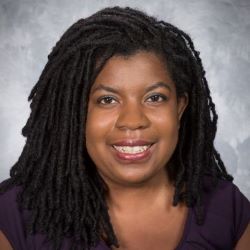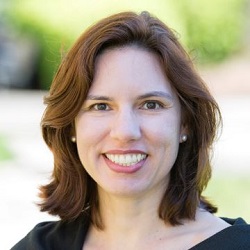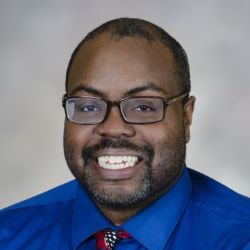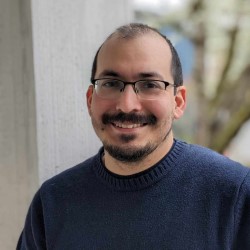Fellow Spotlights
Below are Spotlights featuring several of our OFDIR Fellows and Alumni Fellows. We are so proud of our Fellows and hope to continue expanding the number of Spotlights here!
Dr. Ginnifer Mastarone is multidisciplinary.

Research Focus: assistive technology development, design and implementation
Hometown: Erie, PA
Job: User Experience Researcher at AnswerLab
While at OHSU, her research evaluated how health services were being used by veterans in the hospital system and how the technologies serving them were working or could be improved. Dr. Mastarone says that her work was very rewarding as it united her passions for technology design, work efficacy, and how to ensure patients' access to care.
For Dr. Mastarone, being underrepresented in her field has reinforced that she is right where she belongs. She notes that everyone uses technology, but without a diverse group of people doing the research to design and develop these technologies, the perspectives that inform the work are limited. Dr. Mastarone finds it rewarding to be able to bring her unique perspective to the work she does. She values the opportunities she has to connect and build rapport with study participants from minority backgrounds, as she is sometimes the only researcher they might interact with who looks like them.
On that note, Dr. Mastarone thinks of researchers as a community of people who are deeply invested in trying to understand how the world works. Therefore, they must open the door for people with different perspectives and backgrounds to participate in research as both participants and investigators. While this may take a little bit longer or cost a little bit more, we must seek out both the research questions and the participants who represent our diverse world.
Dr. Mastarone shared that her time in the OFDIR program was transformative. Through the mentorship she received, she discovered that there were many unique paths she could take as a social scientist in the STEM field and felt empowered to explore and pursue them. Dr. Mastarone currently designs and develops technology for many markets. She specializes in and is an advocate for accessible technology design.
Dr. Cristiane Miranda Franca is resilient.

Research focus: tissue engineering, oral pathology, organs-on-a-chip
Hometown: Goiânia, State of Goiás, Brazil
Job: Research Assistant Professor, Department of Restorative Dentistry, School of Dentistry, OHSU
She works with a multidisciplinary team to develop and test a "tooth-on-a-chip" device that demonstrates in real time how cells in the tooth react to bacterial challenge and other dental materials. The device helps improve dental restoration materials and techniques.
Before coming to OHSU, Dr. Miranda Franca was the Principal Investigator of a successful research program in Brazil. When her family decided to move to the U.S. to seek better opportunities, Dr. Miranda Franca faced language and cultural differences while also starting from scratch to build a knowledge base and establish herself in a new research area. She shares that overcoming these career barriers while she and her family also adapted to a new hometown required time, hard work, and stubborn optimism.
From a young age, Dr. Miranda Franca says, her family invested in her and her education, teaching her that she could accomplish her goals with hard work and dedication. She notes, though, that this is not the reality for most women from underrepresented backgrounds. She sees how many women are not supported in using their voice, going to college and graduating, and balancing career goals with expectations about motherhood and family life.
When asked about increasing diversity in the research workforce, Dr. Miranda Franca stated that recruitment and training of underrepresented individuals is crucial. She notes, though, that without a truly empathetic work environment where all people feel they belong and can be their best self, retention is unsustainable. One reason Dr. Miranda Franca chose academia was to create social change through science. As a mentor for students from underrepresented backgrounds, she empowers and encourages, sharing the same support she received in her science and academia career path.
Dr. Eugene Manley, Jr. is barrier-breaking.

Research Focus: Improving tissue imaging methodology
Hometown: Detroit, MI
Job: Founder and CEO, SCHEQ (STEMM & Cancer Health Equity) Foundation
Dr. Manley was the youngest in his immediate family to go to college. He was also the first in his family to earn a PhD. Because of this, he had to learn how to navigate the complex system of academia and the STEM field on his own.
Dr. Manley's work on tissue imaging has focused on developing a panel of antibodies that can be used for digital pathology in mice. In the course of his research he has developed an imaging method that facilitates an understanding of disease development in mice. His findings are an asset for other researchers using mouse models.
As a black scientist, Ph.D. and researcher, Dr. Manley has often had to deal with prejudice and a lack of support in professional and educational settings. In spite of many challenges, he continues to persevere and excel in a field that desperately needs to do better when it comes to diversity, equity, and inclusion.
When we asked Dr. Manley about his time in the OFDIR program, he said that, while there were ups and downs, he had some great experiences. In his words, "the office really did help me in connecting with other minority scientists and admins on campus, and gave me a group that I could talk to." Dr. Manley mentioned that the grant support provided to fellows was a welcome resource.
Having finished his postdoctoral fellowship at OHSU, Dr. Manley moved to the East Coast where he continued his advocacy for equity in STEMM (Science, Technology, Engineering, Mathematics, and Medical). He is the Founder and CEO of the SCHEQ (STEMM & Cancer Health Equity) Foundation - a New York city-based, black-led nonprofit organization dedicated to address and mitigate some of the structural and systemic barriers that impede entry of underrepresented individuals into STEMM fields, and their advancement and promotion in STEMM fields.
Dr. Robert Hermosillo is passionate.

Research Focus: genetics of neural networks
Hometown: El Paso, TX
Job: Research Scientist, Department of Psychiatry & Behavioral Sciences - (Interventional Psychiatry Lab), the Department of Pediatrics, Masonic Institute for Developing Brain, and the Center for Developmental Neuroimaging, University of Minnesota
At OHSU, Dr. Hermosillo started his groundbreaking research mapping brain networks in OFDIR founder, Damien Fair’s lab. Using graph theory, data science, and community detection to map connectivity, Robert has applied his neural network mapping techniques to map the brains of thousands of children and adults to establish an atlas of neural networks, the MIDB Precision Brain Atlas. His current research investigates how interventions, such as medication or neuromodulation influence these neural networks patients, and he joined the Interventional Psychiatry Lab to apply his techniques in guiding neurosurgical interventions for patients with severe treatment-resistant depression.
While at OHSU, Dr. Hermosillo has been a mentor to undergraduate and post-baccalaureate students. He loves training upcoming scientists and watching them learn and get excited about scientific inquiry.
Dr. Hermosillo notes that, for many scientists from underrepresented minorities (URM), success depends on internal drive. Dr. Hermosillo enjoys coming to work every day to figure out bizarre problems with a million different factors. But, he notes, people from minority backgrounds are heavily underrepresented in academia and URM role models can be hard to find.
When asked how institutions can better support URM scientists and staff, Dr. Hermosillo notes that funding speaks. Scientists should be supported not only in words, but practically as well. He also remarked that universities should go above and beyond when it comes to recruiting minority staff and faculty. Working for diversity, equity and inclusion should not be about achieving minimum standards, but about genuinely building support systems from the inside reaching out. If institutions want to retain scientists from minority backgrounds and help them thrive, commitment and institutional support is needed.